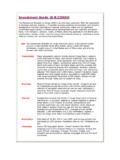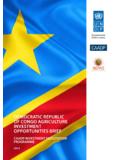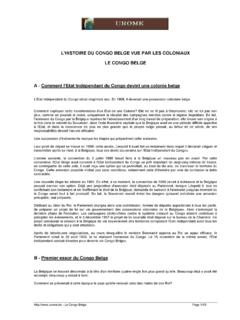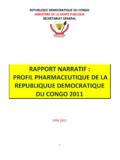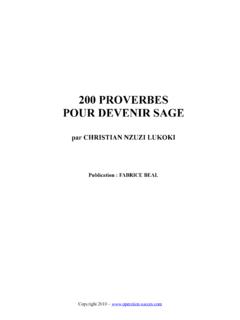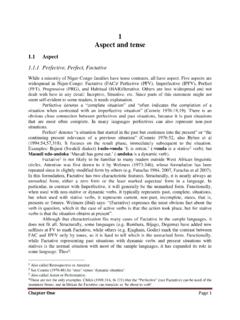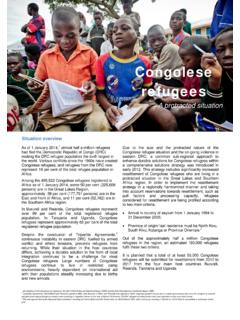Transcription of TSWANA 1. Description 1.1 Name(s) of society, …
1 TSWANA 1. Description Name(s) of society, language, and language family: Botswana Society, TSWANA ( Bechuana ) -- > OLD orthography, TSWANA or Botswana ethnic group; TSWANA or Setswana ( Sechuana ) Language; Niger- congo Language family Population: 3,410,000 in South Africa (2006), increasing ISO code (3 letter code from ): tsn ISO 639-3 Location (latitude/longitude): Bechuanaland Protectorate; southern Africa, north of South Africa; TSWANA is spoken in Botswana, South Africa, Zimbabwe, Namibia Brief history: Between the 1880s and 1960s, Botswana was a poor country and a peripheral British protectorate also known as Bechuanaland. Since its independence in the 1960s, Botswana has gained international stature as a prosperous and peaceful democratic state.
2 Setswana makes up the fifth largest language group in South Africa and most of the speakers of the language are situated in the North West Province of South Africa which borders Botswana. Influence of missionaries/schools/governments/powerfu l neighbors: Botswana was a member of the British Commonwealth with a multiparty political system; Republican form of governance. The TSWANA are divided into eight principal tribes governed by heredity chiefs. Botswana is now a Democratic state. Botswana has had one of the most fastest growing economies of the world due to the mining of diamonds and its mineral. They have built up state revenues. In traditional rural towns and villages, there has been successful development of health and educational facilities.
3 There are rapidly growing new towns also. Ecology (natural environment): farms, cattle ranches and water holes; mining Population size, mean village size, home range size, and density: million people speak the TSWANA Language in South Africa 2. Economy Main carbohydrate staple(s): cultivation of grain; sorghum or corn meal porridge is the staple of most Botswana meals enriched in sour milk and/or sugar, and tea Example of sorghum/corn cultivation Main protein-lipid sources: cattle, chicken, goat, sheep, fish Weapons: Bow and arrow, blowguns?: not found Food storage: Grain forms the bulk of the diet for all residents; high reliance of cattle in cattle posts where livestock are kept Sexual division of production: tasks are distributed based on gender and age.
4 Cattle care is associated with men; women milk cattle; herders are males and housemaids are females Land tenure: 5% of the land in Botswana is freehold, 25% is state land in the form of games reserve, wildlife reservation areas and national parks, and the rest is communal land for tribes such as the TSWANA Ceramics: Bead-work, pottery, basket weaving, wood carving, musical instruments, leather crafts, tapestry Examples of crafts! Specified (prescribed or proscribed) sharing patterns: none found Food taboos: Only salt and water are added to chicken dishes; any other spices are considered taboo Canoes/watercraft? Wooden mekoro (boats) 3. Anthropometry Mean adult height (m and f): not found Mean adult weight (m and f): not found 4.
5 Life History, mating, marriage Age at menarche (f): 11 or 12 yrs old Age at first birth (m and f): not found Completed family size (m and f): The TSWANA tribe was considered to have the smallest family unit consisting of the mother, father and their unmarried children. In some cases, it also included the married sons and daughters and their families. Inter-birth-interval (f): not found Age first marriage (m and f): not found Proportion of marriages ending in divorce: not found Percent marriages polygynous, percent males married polygynously: Polygyny is no longer common Bride purchase (price), bride service, dowry?: cattle is the currency for paying the bride price Inheritance patterns: A man s eldest son inherits most of the cattle and other property.
6 Daughters are sometimes given livestock, but remains with her brother until she is married, in which case it is transferred directly to the husband. Daughters inherit their mother s household utensils Parent-offspring interactions and conflict: Both sexes nurture the children. Usually a young mother is not considered ready to entirely care for her children. They are usually cared for by a relative such as aunt or grandmother. Homosexual activities, social attitudes towards homosexuals: Among the TSWANA (in addition to homosexuality among the men laboring in the mines), it was reported that back home, lesbian practices are apparently fairly common among the older girls and young women, without being regarded in any way reprehensible Pattern of exogamy (endogamy): Sotho patrilineages were usually endogamous - the preferred marriage partner would be a person related through patrilineal descent ties.
7 What is the belief of the role of males in conception; is paternity partible? Are these other fathers recognized? Not found What is the belief of the mother s role in procreation exactly? ( , receptacle in which fetus grows ) this was not found Is conception believed to be an incremental process ( , semen builds up over time)? Information not found Occurrence of sexual coercion, rape: none found Preferential category for spouse ( , cross cousin) : not found Do females enjoy sexual freedoms? A TSWANA woman was always seen as a permanent minor, always under men s authority so they lacked sexual freedoms. Evidence of giving gifts to extramarital partners or extramarital offspring: cattle If mother dies, whose raises children?
8 Most likely the grandmother would raise the children if the mother were to die. Adult sex ratio: number of adult males divided by number of (reproductive) females: not found Evidence for couvades: No direct evidence for couvades Different distinctions for potential fathers ( , lesser/younger vs. major/older): there is a lesser distinction for younger boys as potential fathers Kin avoidance and respect? Agnation is emphasized in Batswana kinship: along with primogeniture, it traditionally had the greatest influence on inheritance of property and succession to office. Individuals were identified with and came under the jural authority of their agnatic group ( kgoda, or the diminutive kgotlana ); however, the formation of discrete agnatic units was and continues to be inhibited by the marriage system, which permits cousin marriages of all kinds.
9 Patrilineal parallel-cousin marriages of near kin, although practiced mainly by the elite but permitted to all, serve to complicate the principle of unilineality and create ambiguous and overlapping links. Thus, there is a cognatic element to the system, which places emphasis upon kindreds (sing. losika ) and gives greater license to individuals to "construct" their social networks than is found in many patrilineal societies . Joking relationships? None Patterns of descent ( , bilateral, matrilineal) for certain rights, names or associations: Incest avoidance rules: None found Is there a formal marriage ceremony? According to what I have observed from the weddings in Botswana, one thing is certain, a wedding cannot take place without first partaking in what is known as the patlo.
10 The patlo is the ceremony where the bridal price lobola is handed over or paid out to the bride s family. Prior to the patlo, negotiations are carried out back and forth usually by the spouses aunts and uncles to determine the bridal price and how it shall be paid out at the patlo. The patlo is known as the traditional wedding, thus after the ceremony, the couple are known and can be referred to as bridal is paid out in the form of cattle or cash equivalent to the price of purchasing the requested number of the couple wishes, then and only then can they proceed to have what they call a white or church wedding where the bride wears a white dress, and walks down the isle as is the custom of most weddings around the world.
